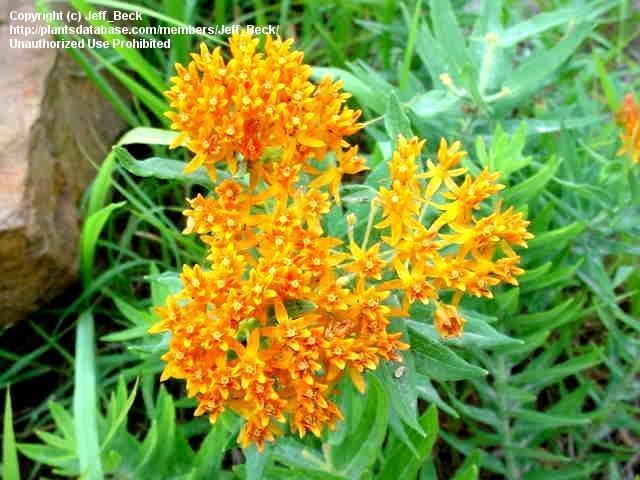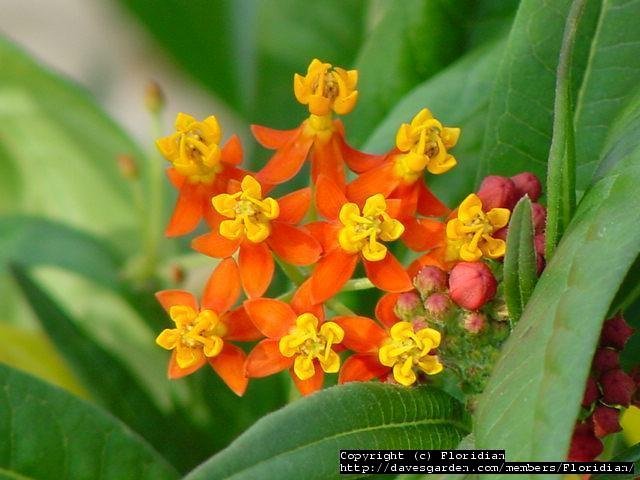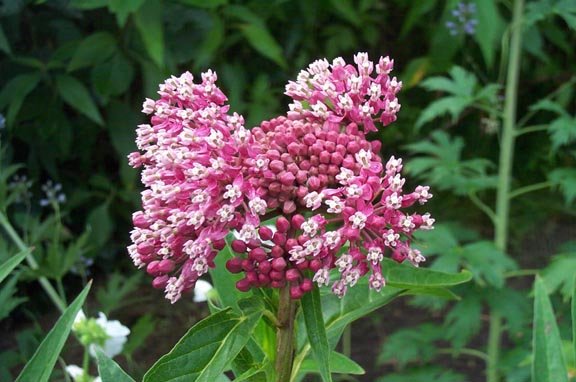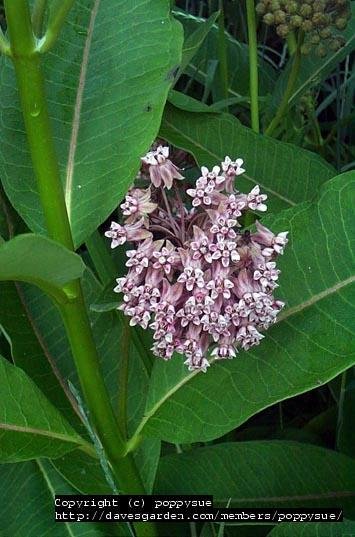





"Monarchs need milkweeds." That's practically Rule # 1 of butterfly gardening. But a novice gardener could easily be frustrated by the challenge of choosing the right plant. Let me help you understand what IS a milkweed, "monarchically" speaking, what isn't a milkweed and how to choose the right milkweed for your garden.
I thought I was fairly well acquainted with monarch-approved milkweeds. But when I searched Dave's Plantfiles for "common name: milkweeds", I found one glaring omission and some confusing inclusions. The popular perennial butterfly weed (Asclepias tuberosa) was nowhere to be seen. How could that be? My mistake lay in searching by a common name, milkweeds, instead of by the more specific Latin name. And there were things called milkweed that I have never heard of, and knew did not qualify as monarch caterpillar fodder. It seems that the name milkweed has been applied to some of the Euphorbias, plants which have milky sap but are but very distant cousins to the desired milkweeds. And don't confuse your butterfly WEED with butterfly BUSH (Buddleja). The bush is a great nectar source but a lousy food choice for monarchs.
To be accurate, monarch caterpllars feed on plants from the family Asclepiadaceae and primarily from one genus, Asclepias, in that family. But I don't want to lose you in a mire of Latin terminology. Can we just stop at understanding that when you want a monarch munchable milkweed you should look within the genus Asclepias? And when browsing that genus, the name Asclepias can be denoted by the initial A., and followed by another odd looking word (the species or specific epithet) after it. But my goal is not to delve into Latin names, but to simplify the issue; that is, to help you choose a milkweed that'll both please you in the landscape and feed your monarchs. The following list highlights several popular choices. Each common name that I use here is followed by a shorthanded Latin name. When you see the Latin name as you shop, you'll know for sure just which milkweed you're buying.

A full-sun perennial with bright orange flowers on a tidy, bushy two foot plant.
This butterfly weed is the most popular Asclepias in the nursery trade. Butterfly weed (tuberosa) can be grown from seed or bought as a nusery plant. If bought in a pot, transplant with care, trying not to disturb or break the roots at all. This plant suffers greatly if the tap roots are broken. For that reason, a small young plant is a better buy than a large old one. Give the plant good care when it is young, and you'll be rewarded; this milkweed is extremely drought tolerant once well rooted. Of the popular cultivated mlkweeds, this would be the best bet for keeping a tidy appearance. Butterfly weed is also native to most of North America.
~~ ~~ ~~ ~~ ~~ ~~ ~~ ~~

An annual/ tender perennial for full sun, bearing yellow and red bicolored blooms, or solid bloom clusters of one of those colors, on three to five foot tall stems.
Scarlet milkweed is a popular annual milkweed. Seed (which must have a moist cold stratification period) is started indoors in early spring for shorter--summer zones, or outside in warmer areas. Scarlet milkweed is reported as drought tolerant but will grow more lush with moist conditions. It can be a prolific seed producer. That's great news for sharing, or keeping yourself well supplied, but not great news if you have concerns about excess weeding or the plant's spread to other areas. (Milkweed foliage contains toxic compounds). Scarlet milkweed is naturalized in several of the hottest United States.
~~ ~~ ~~ ~~ ~~ ~~ ~~ ~~ ~~
 Perennial for sun or part shade, moist locations, this milkweed bloooms in pink or white on three to five foot tall stems.
Perennial for sun or part shade, moist locations, this milkweed bloooms in pink or white on three to five foot tall stems.
Swamp milkweed, you will not be surprised to hear, is a great choice for swampy, poorly drained areas. It's also fairly easy to grow from seed, using the same method as you would for Scarlet milkweed (above) The "winter sowing" technique is perfect for this kind of seed. Swamp milkweed grows lovely green stems covered with thin leaves and topped by the typical milkweed flower cluster. Flowers will be followed by erect, attractive thin pods.
~~ ~~ ~~ ~~ ~~ ~~ ~~ ~~ ~~

A perennial to zone 3, sun to part shade in a wide range of conditions, it bears large pink flower clusters on four to five foot tall, thick stems.
Common milkweed is a widespread wildfower. Also native in North America, it's a common wild sight in almost the entire eastern two thirds of the continent. In early summer, the thick stems are topped with large, pink, fragrant flower clusters. Big nectaring insects like bumblebeesgo nuts over these blooms. Unfortunately for the gardener, common milkweed leaves tend to yellow and drop though the summer, leaving unattractive bare stems topped by fat pods in the fall. Monarch caterpillars need not go hungry though; established common milkweed often sends up new tender stems in late summer. You can gather and sow seeds of this milkweed just like the previous ones. I started my patch that way. A word of warning on this milkweed: it sends out thick rhizomes about six inches underground. It came become a real garden pest!
~~ ~~ ~~ ~~ ~~ ~~ ~~ ~~ ~~
There are a number of other species of Asclepias milkweed that you could explore. Wikipedia's "monarch butterfly" entry supplies a list of appropriate choices for host plants for monarch caterpillars.
And Dave's Garden PlantFiles is s good place to start reading more about some of those other, less commonly grown plants.
~@~ ~@~ ~@~
Thanks to DG Uber Gardeners Floridian, Jeff Beck and poppysue for their pictures submittedto Plantfiles and used here. Thumbnail picture taken by and property of the author.
Copyright © www.100flowers.win Botanic Garden All Rights Reserved